
Southern California Edison (SCE), the largest subsidiary of Edison International, is the primary electric utility company for much of Southern California. It provides 15 million people with electricity across a service territory of approximately 50,000 square miles. However, the Los Angeles Department of Water and Power, San Diego Gas & Electric (SDG&E), Imperial Irrigation District, and some smaller municipal utilities serve substantial portions of the southern California territory. The northern part of the state is generally served by the Pacific Gas & Electric Company of San Francisco. Other investor-owned utilities (IOUs) in California include SDG&E, PacifiCorp, Bear Valley Electric, and Liberty Utilities.

Ameren Corporation is an American power company created December 31, 1997, by the merger of St. Louis, Missouri's Union Electric Company and the neighboring Central Illinois Public Service Company of Springfield, Illinois. It is now a holding company for several power companies and energy companies. The company is based in St. Louis, serving 2.4 million electric, and 900,000 natural gas customers across 64,000 square miles in central and eastern Missouri and the southern four-fifths of Illinois by area.
The Union Electric Company of Missouri was an electric power utility that was organized in 1902 and grew to be one of the large U.S. companies listed among the S&P 500. In 1997, its holding company merged with a smaller neighboring utility, Central Illinois Public Service Company through its holding company, CIPSCO Inc., to form Ameren Corporation based in St. Louis, Missouri.

The Hartford Electric Light Company (HELCO) is a defunct electrical company that was located on Pearl Street in Hartford, Connecticut. HELCO merged with the Connecticut Power Company in 1958. These merged with the Connecticut Light and Power Company (CL&P) and the Western Massachusetts Electric Company (WMECO) in 1966 to form Northeast Utilities (NU). Its former corporate headquarters building and main facility are in the Ann Street Historic District.

Folsom Powerhouse State Historic Park is a historical site preserving an 1895 alternating current (AC) hydroelectric power station—one of the first in the United States.

Lock and Dam No. 19 is a lock and dam located on the Upper Mississippi River near Keokuk, Iowa. In 1978, the Keokuk Lock and Dam was listed in the National Register of Historic Places, #78001234. In 2004, the facility was listed in the National Register of Historic Places as Lock and Dam No. 19 Historic District, #04000179 covering 1,605 acres (650 ha), 7 buildings, 12 structures, 1 object. The lock is owned and operated by the U.S. Army Corps of Engineers. The dam is owned and operated by Ameren Missouri.

Croton Dam is an earth-filled embankment dam and powerplant complex on the Muskegon River in Croton Township, Newaygo County, Michigan. It was built in 1907 under the direction of William D. Fargo by the Grand Rapids - Muskegon Power Company, a predecessor of Consumers Energy. The 40-foot-high (12 m) dam impounds 7.2 billion U.S. gallons (6 billion imp. gal/27 billion L) of water in its 1,209-acre (489 ha) reservoir and is capable of producing 8,850 kilowatts at peak outflow. It was listed on the National Register of Historic Places in 1979.
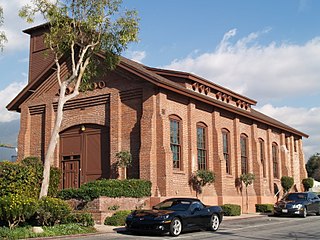
Pacific Electric Railway Company Substation No. 8, also known as the Altadena Substation, is a former traction substation in Altadena, California. It operated under the Pacific Electric Railway and served as the substation for Pasadena area lines.

The Waltham Gas and Electric Company Generating Plant is a historic power company generator building at 96 Pine Street in Waltham, Massachusetts. Built c. 1900–1909, this large concrete-and-stone building is an essentially unaltered early power generation plant, although all of its window openings have been filled with concrete. It originally housed a steam power generator, and was sold by Waltham Gas and Electric to Boston Edison, who converted it to an electrical substation in 1917, a role it continues to fulfill.

The former Saratoga Gas, Electric Light and Power Company Complex is located near the northern boundary of Saratoga Springs, New York, United States. It is a seven-acre parcel with two brick buildings on it. In the 1880s it became the thriving resort city's first power station.

The Illinois Traction System Mackinaw Depot is a former in use 1909 to 1953 Illinois Terminal Railroad interurban passenger depot in Mackinaw, Illinois that still stands. The Illinois Terminal Railroad ran an over head trolley wire powered railroad from Peoria on the north to St.Louis on the south with branches to Champaign and Urbana. The brick depot and rotary converter "substation" was built in 1909 and designed in the Spanish Colonial Revival style. The station served regularly scheduled electric interurban passenger trains and electric locomotive powered freight trains. The Illinois Power and Light Company also used the building as an electrical substation from 1927 until 1955. Very high voltage alternating current was converted to 600 volt direct current for use by the interurban line's locomotives and interurban cars. Wires entered and left through the large holes in the upper portions of the depot. The station was one of several properties owned by the IT at Mackinaw along with adjacent mainline track and a number of rail sidings, but the other buildings and the track have since been demolished leaving the depot as the only surviving landmark from the era of electric interurban trolley service in the central Illinois area.
Two-thirds of energy in Azerbaijan comes from fossil gas and almost a third from oil. Azerbaijan is a major producer of oil and gas, much of which is exported. Most electricity is generated by gas-fired power plants.
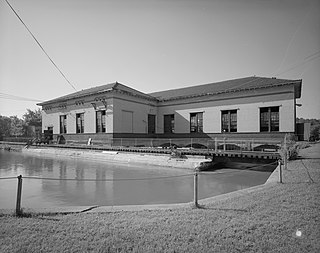
The Marseilles Hydro Plant, also known as the Marseilles Hydro Development or the Marseilles Hydro Power Station, is a historic hydroelectric power station along the Illinois River in Marseilles, Illinois, USA.

The Portland General Electric Company Station "L" Group in southeast Portland in the U.S. state of Oregon was a cluster of six industrial buildings listed on the National Register of Historic Places. Built between 1910 and 1929 by Portland General Electric (PGE), it was added to the register in 1985. In 1986, PGE gave Station L and 18.5 acres (7.5 ha) of land to the Oregon Museum of Science and Industry (OMSI). The Station L turbine is a central feature of OMSI's Turbine Hall. The complex was listed on the National Register in 1985, and was delisted in 2020.

The Pacific Electric Sub-Station No. 14 is a former traction substation in Santa Ana, California. It was built by the Pacific Electric Railway to provide electricity to run the railway's streetcars in central Orange County, California. The building was added to the National Register of Historic Places in 1983.
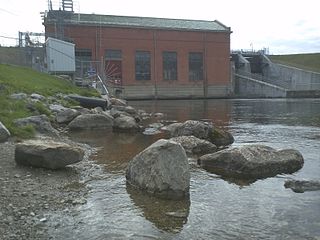
Cooke Dam is a hydro-electric dam on the Au Sable River in Michigan. It was listed on the National Register of Historic Places in 1996 as the Cooke Hydroelectric Plant.

The Stairs Station Hydroelectric Power Plant was built in 1894-1895 in Big Cottonwood Canyon, about 8 miles (13 km) southeast of Salt Lake City, Utah. The plant comprises the powerhouse, switchyard, penstocks, and a pipeline. A dam next to the site is associated with the Granite Power Plant farther downstream, and is part of neither historic district. The powerhouse is the only remaining building associated with the plant. It is an example of an intact high-head generating plant from the late 19th century.
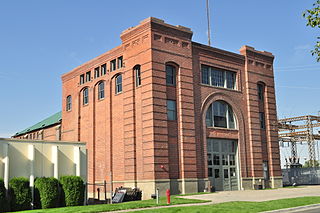
The Electric Light Works Building, also known as Gesa Power House Theatre, is a noteworthy building in Walla Walla, Washington that has aided in the growth and success of the city. It started out as a substation in the early 20th century, supplying Walla Walla with electricity. It was one of the first substations that converted hydropower to electricity in Washington state and is a good example of industrial architecture in the 1900s. Today it is as much a symbol of Walla Walla’s history as it is of the ever-changing culture of Walla Walla.

The Post Street Electric Substation is an electric substation on the Spokane River in the city of Spokane, Washington. Built in 1910, the Post Street substation served the needs of the city's growing electric grid as well as the surrounding area. The substation consolidates and delivers power generated by the Upper Falls Dam and the Monroe Street Dam hydroelectric plants. The building is one of many contributions to Spokane's downtown area by renowned Pacific Northwest architect Kirtland K. Cutter.
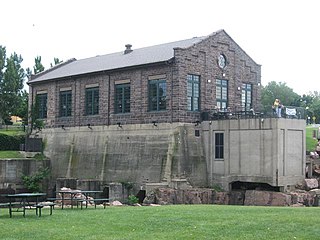
The Sioux Falls Light and Power Hydro Electric Plant, formerly the Northern States Power Building, is a historic building in Falls Park in Sioux Falls, South Dakota. Originally built as a hydroelectric power plant on the Big Sioux River, it now houses the Falls Overlook Cafe. It was listed on the National Register of Historic Places in 1993.




















